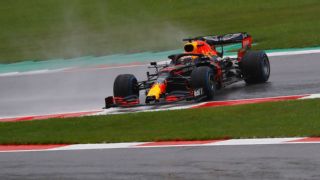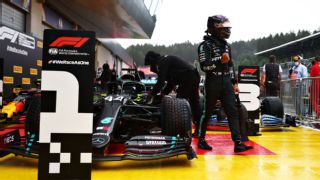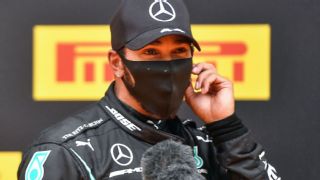|
Make no mistake, Lewis Hamilton's pole position lap at the Styrian Grand Prix will feature prominently in Formula One's archive of great wet-weather performances. Modern F1 is usually too competitive to allow margins of over a second between first and second on the grid, yet Hamilton managed to qualify 1.216s clear of his closest competitor, Max Verstappen. The last time someone held such a big advantage over the rest of the field was at the 2017 Italian Grand Prix and, you guessed it, it was Hamilton leading the way during that wet session too. While it's true that Verstappen would have been closer had he not spun on his final lap, the fact he made a mistake and Hamilton did not tells you a lot about how good the pole lap was. Besides which, Hamilton was already 0.408s faster than Verstappen through the first two sectors, so the margin was still set to be significant regardless of Verstappen's mistake.  So, how did Hamilton do it? Raw talentFirst and foremost, there is an element of natural talent that can't be overlooked. Unlike in the dry when braking points and throttle traces can be analysed between runs and improved upon in near identical conditions, a wet track presents a changing picture. Hamilton was actually 1.4s slower in Q3 than he was in Q2 due to a downpour between the two sessions, but that takes nothing away from how impressive his lap was. If anything, it makes it more impressive as the level of water on the track was causing aquaplaning (when a layer of water stands between the tyre and tarmac, causing the car to slide) and was close to the limit of what was safe. "It was the worst conditions we could probably get these cars around in," Hamilton said. "It was an incredible challenge. Visibility was very, very minimal. "A lot of the time you can't even see where you are going. I had one big moment, I think the lap before the last, a big aquaplane, which definitely had my heart in my mouth, but it was able to improve on the next lap, nice and clean. I love these days.  Watch the onboard footage of Hamilton's lap and you'll see him moving off the traditional racing line to find grip. Using unusual parts of the track in the wet is something drivers learn in go karts, where the traditional racing line is so layered with rubber that it becomes slick and slippery when wet. With Hamilton's lap, you see him brake off the usual line, take the corners with a line of least resistance and then move back off the line under acceleration. It's not quite a traditional 'karting line' around the outside of the corner, but the same principle of knowing where the grip is applies. "That last lap was really as close to perfect as I could get it in those conditions," Hamilton added. "And considering it was raining more, it makes me even happier knowing that I went a little bit quicker during that time. "You have to be very dynamic with your driving style from corner to corner because the wet patches arrive, the puddles are shifting about with the cars that are driving ahead of you, which is a massive challenge." Sat in the Mercedes the garage, team boss Toto Wolff, who used to coach drivers at the Red Bull Ring in his youth, watched on in awe. "Very rarely do you see performances that are just not from this world," he said. "When you look at the onboard of his lap, he was balancing the car on the edge, aquaplaning, the throttle control was incredible." Engineering excellence But an F1 car is not a go-kart and there is a huge amount more going on to put a perfect lap together. As is so often the case in F1, the tyres are key, and keeping the wet compound (which is very soft and operates at lower temperatures than the slick tyres) at the right temperature is key. "I would say driver and car merge into one [on a lap like that]," Wolff explained. "Where a perfect car, with the tyres in the right window, and perfect drivability on the power unit come together with the skill and the intelligence of a racing driver. Only then do you see these kinds of performances." There were suggestions after the session that Mercedes' unique DAS system, which is controlled by the driver and can be used to regulate the temperature of the front tyres, offered an advantage to Hamilton and teammate Valtteri Bottas that rival drivers did not have. But, unlike during last week's dry qualifying session, Wolff claims neither driver used it. "I don't think we have been using DAS on any of the laps," Wolff said. "Tyre temperatures definitely play a role and you can see that on the last line up in the pits -- some teams had very hot tyres, even steaming -- and others not. "So I think it is more about the setup in the session itself and how you get the tyres into the right temperature window, because if you are not doing that properly you are lacking grip. If you overheat then you are on the other end of the spectrum and that is equally detrimental." Communication It should also be said that it is not a solo effort. Hamilton's engineer, Peter Bonnington (known as Bono within the team), was in constant communication with his driver during the session, warning him about the positioning of other cars on track and coaching him through the various engine and car settings to get everything in the right window. It's a relationship that is key to success and, despite Hamilton telling Bonnington to stop talking at one stage, he wouldn't have been able to achieve his full potential without him. "Communication really is vital and I think the rapport you have with your engineer, you have to have a good relationship, a good understanding of each other," Hamilton said. "It's something I discuss. Bono and I have discovered over time how to lean on each other and when not to. "So, I think the communication was really perfect. I couldn't have done it without him and when you're out there, you really feel very, very lonely because there's a cloud of spray ahead of you and then the same behind. You don't know where anyone is, you don't know what time it is, all you know is that you're going super-fast." Bonnington is the only voice communicating with Hamilton during a qualifying session, but he is part of a much longer chain of command that reaches all the way up to Wolff. It includes people looped in from the team's factory in Brackley as well as those sat on the pit wall, and the organisation of that flow of information is described by Wolff as a "verbal ballet". "I think in these conditions, you really need to be sharp to advise the driver where the gaps are [to other cars], how the weather develops and the driver will feedback what he sees on the track," he said. "The intercom protocol needs to be very precise. "If you would hear the verbal ballet that is going on on the intercom between everybody -- on the pit wall and in the garage -- I must say, I am really proud and impressed how it happened today because it is about finding the right spot on the track, analysing the weather and about deciding when to put the engine in recharging mode or when to deploy the [full power] party mode, which doesn't last for long. "That was perfectly synchronised today." Self belief But above all else, the driver has to be in the zone. He has to be able to process all of that information without getting hung up on it. He has to search for the limit of grip without spinning out. Ultimately, it is his raw talent and years of experience that makes the difference. "I think it's difficult for an athlete to explain why they're good at something," Hamilton said. "I know how good I am and that's the belief that we have to have inside of us, all of us. "I think that's the same for every athlete. I think it should probably apply to everyone doing their jobs around the world; people try to be the best and believe that you can be the best and at some point, hopefully, you do believe you're the best. "But yeah, it's down to focus, it's down to how you study the track and your ability to be dynamic and manage the trickiest of conditions with the pressure on you. That's generally what the best athletes in the world do. "In the last moments of an NBA game, when you've got Ray Allen taking that three point shot, when that one counts... either it gets you through or not. "That's really what makes those individuals stand out."
|
